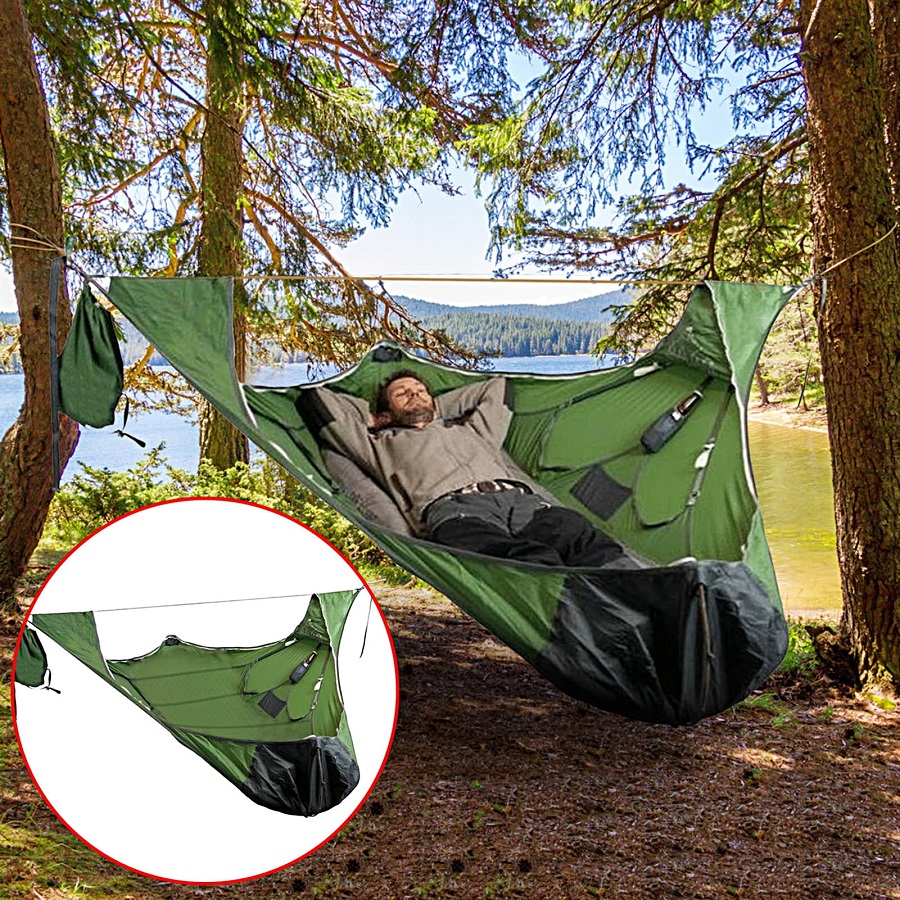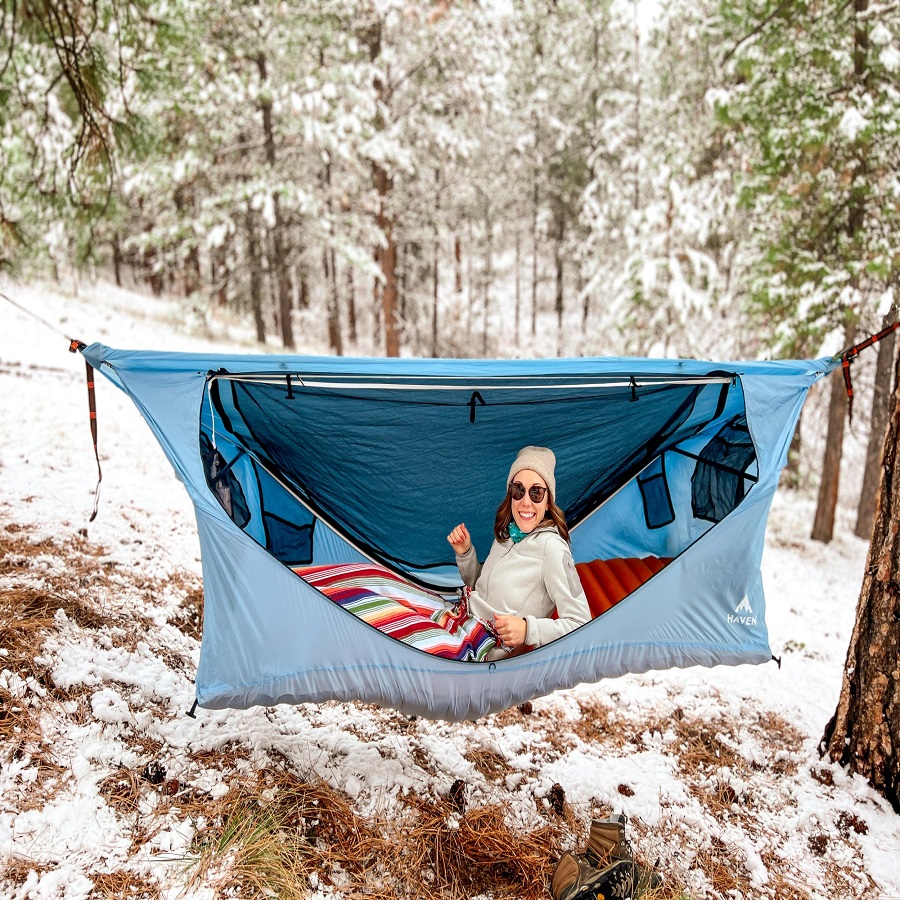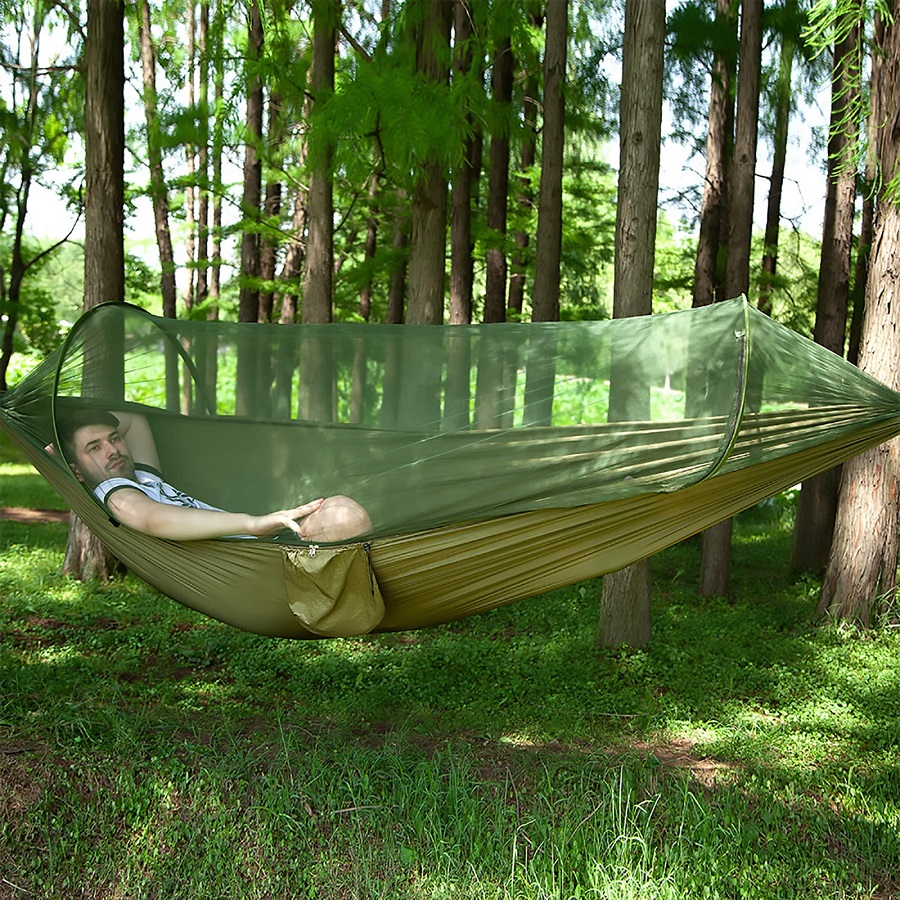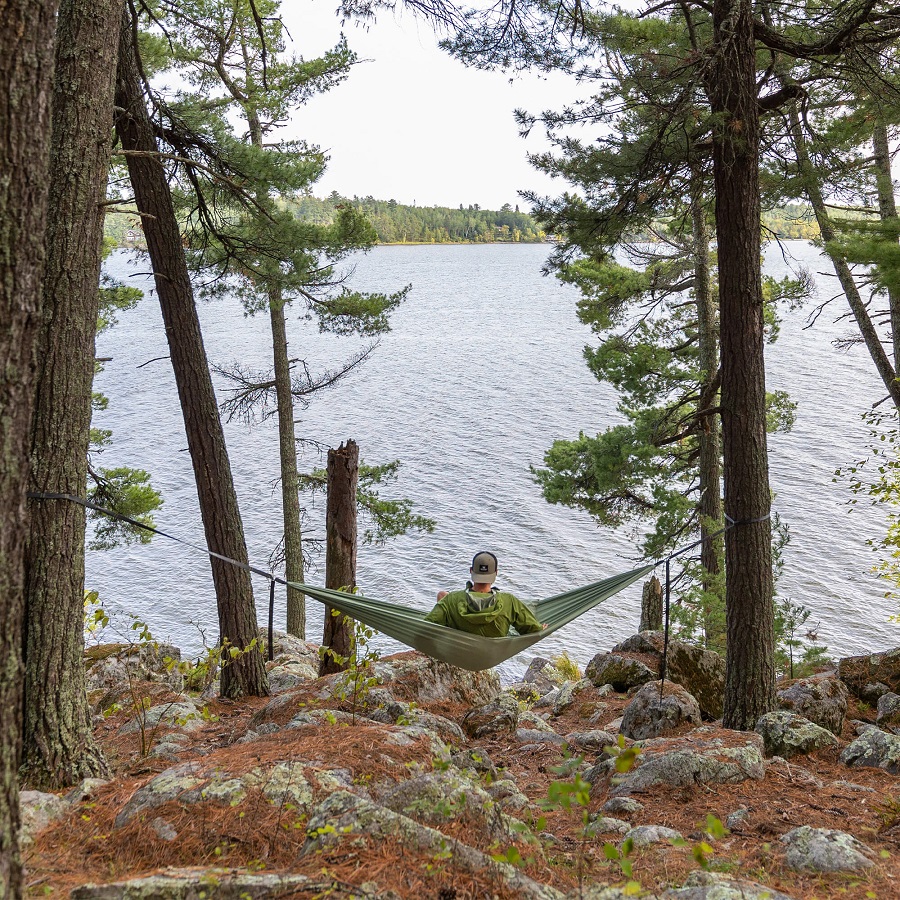Choosing the Right Henderson Hammock
Selecting the right Henderson hammock is crucial for a comfy and safe camping experience. Here’s what you need to consider:
Types of Hammocks and Their Features
Hammocks come in various designs, each suited to different camping needs:
- Parachute Hammocks: These are durable and can accommodate two people, perfect for partners.
- Ultra-Light Hammocks: Best for backpackers, they are light and easy to carry.
- Expedition Hammocks: Made for harsh conditions, they often include mosquito nets and rainfly.
Each type combines quality materials and stability, key traits of Henderson hammocks.

Benefits of Using Henderson Hammocks for Camping
Why pick a Henderson hammock for your trip? The perks are clear:
- Comfort: They conform to your body shape, offering a restful sleep.
- Versatility: Use them almost anywhere – just need two anchor points.
- Portability: They are lighter than tents, freeing up your pack for other essentials.
Henderson hammocks also promote elevated sleeping, away from ground critters.
Key Factors to Consider When Selecting a Hammock
Keep these pointers in mind when choosing your hammock:
- Size and Weight Capacity: Ensure it fits you comfortably and can hold your weight.
- Material: Look for durable, weather-resistant fabrics.
- Ease of Set-Up: Quick, intuitive setup is key for camping.
- Accessories Compatibility: Make sure it works with essential add-ons.
Henderson hammocks often come with user-friendly features, so always check product specs.
Setting Up Your Hammock
Properly setting up your Henderson hammock is essential for a comfortable and secure camping experience.
Finding the Perfect Spot
Choosing where to hang your hammock is the first step. Look for a location with:
- Sturdy Trees or Anchor Points: These should be solid and at least 12-15 feet apart.
- Level Ground Below: In case of a fall, flat ground reduces the chance of injury.
- Good Surroundings: Make sure the area is clear of hazards like sharp rocks or unstable branches.
Ensure that the spot you pick follows the Leave No Trace principles to minimize environmental impact.
Securing the Hammock Safely
Once you have your spot, it’s time to secure your hammock. Here’s how:
- Use Reliable Straps: Quality straps prevent tree damage and ensure your hammock stays in place.
- Check Knots and Carabiners: Make sure all connections are tight to avoid slips.
- Inspect for Wear and Tear: Look for signs of damage on the hammock and suspension system before use.
By securing your hammock safely, you can rest without worry.
Adjusting for Comfort and Stability
Comfort in a hammock comes down to fine-tuning the tension and angle. Strike the right balance with these tips:
- Find the Ideal Sag: Aim for a 30-degree angle from the anchor points to maximize comfort.
- Test and Readjust: Lie in your hammock and adjust the straps as needed for the best fit.
- Balance Weight Distribution: Center yourself to prevent tipping and enhance stability.
With these adjustments, your hammock will be ready for restful sleep in the great outdoors.
Essential Accessories for Hammock Camping
When planning your hammock camping adventure, consider these key accessories to enhance your experience.
Straps, Ropes, and Carabiners
High-quality straps and ropes are vital for a secure setup. Opt for straps that are gentle on trees and have a strong load capacity. Carabiners provide a reliable connection between your hammock and the suspension system. Select ones that are lightweight yet sturdy.
Hammock Tarps for Weather Protection
A durable hammock tarp is your best defense against the elements. It shields you from rain, wind, and sun. Ensure it’s large enough to cover your hammock entirely and easy to set up.
Underquilts and Sleeping Pads for Insulation
Cold nights call for proper insulation. An underquilt hangs below your hammock to trap body heat. A sleeping pad inside the hammock adds comfort and warmth. Choose materials that retain heat and resist moisture for the best protection.

Packing for Your Trip
Preparing for a hammock camping excursion involves thoughtful packing to ensure you have everything you need without overloading your backpack. Henderson hammock enthusiasts favor a minimalistic approach, emphasizing the essentials and embracing the lightweight advantage of hammock camping.
Checklist of Camping Essentials
To kick-start your packing, create a checklist of camping essentials to cover your basic needs:
- Shelter: Your Henderson hammock, straps, and tarp.
- Sleep System: A sleeping pad or underquilt for insulation.
- Clothing: Weather-appropriate apparel and a set of dry clothes.
- Cooking Gear: A portable stove, fuel, and lightweight cookware.
- Food: Non-perishable, high-energy food items.
- Water: A refillable water bottle and purification method.
- Navigation Tools: A map, compass, or GPS.
- First Aid Kit: Basic medical supplies and personal medications.
Remember to tick each item off as you pack to ensure nothing is forgotten.
How to Pack Light with a Hammock
With your Henderson hammock, packing light is more manageable:
- Consolidate: Choose multipurpose items.
- Use Compression Sacks: Shrink down bulky items.
- Limit Clothing: Pack only what you need.
Focus on what’s essential and cut down on extras that add unnecessary weight.
Food and Water Considerations
Food and water are critical, but with careful planning, they won’t weigh you down:
- Choose Dehydrated Meals: Save weight and space.
- Plan Meals Ahead: Avoid excess by knowing exactly what you’ll eat.
- Water Filtration: Bring a lightweight filtration system instead of multiple water bottles.
By strategizing food and water packing, you’ll keep your load light and your energy high.
Leave No Trace Principles
Adhering to Leave No Trace principles is vital for preserving natural spaces.
Minimizing Impact on the Environment
When hammock camping with your Henderson hammock, minimizing your impact is key. Follow these steps:
- Choose Existing Campsites: Use established spots to reduce harm.
- Avoid Sensitive Areas: Stay clear of delicate ecosystems, like wetlands.
- Go Light on the Land: Stick to durable surfaces to lessen your footprint.
- Leave What You Find: Don’t take natural items or leave any behind.
- Be Mindful of Fire: If allowed, keep fires small and manage them carefully.
These guidelines help protect the environment during your hammock adventures.

Campsite Restoration Tips
Before you depart, ensure your campsite looks untouched:
- Remove All Trash: Pack out everything you brought in, without exception.
- Disassemble Structures: Take down any hammock setups or shelters.
- Naturalize the Area: Scatter leaves or twigs to hide signs of your stay.
- Check for Erosion: If your presence caused erosion, try to repair it.
Restoring the site helps the next visitors enjoy a pristine environment, just as you did.
Safety and Precautions
Ensuring safety is a top priority during any hammock camping adventure. Careful precautions protect you and the environment.
Inspecting Gear Before Use
Before settling into your Henderson hammock, always inspect your gear. Check for any rips, tears, or weak spots in your hammock. Ensure straps and carabiners are free from damage and wear. This check keeps you secure and extends the life of your equipment.
Dealing With Wildlife
Encountering wildlife is part of the camping experience. Store food in airtight containers to avoid attracting animals. Learn about local wildlife and how to react in their presence. Keep a safe distance from any animals you encounter.
Emergency Preparedness
Be ready for emergencies by packing a first aid kit and learning basic first aid. Know the location of the nearest medical facility. Carry a whistle or other signaling device. Share your trip itinerary with someone reliable before leaving. Making these preparations ensures help is available if you need it.
Tips for a Great Henderson Hammock Experience
To ensure a fantastic experience with your Henderson hammock, consider these tips:
Best Practices for Comfortable Sleep
Getting a good night’s sleep is key to enjoying your hammock camping trip. Here are some tips:
- Use a Pillow: A small, travel-sized pillow can add comfort to your neck and head.
- Stay Warm: Ensure you have enough insulation, like an underquilt, to avoid a cold night.
- Sleep Diagonally: This position helps you lie flatter and reduces the cocooning effect.
- Limit Noise: Use earplugs if you’re a light sleeper, as nature can be noisy at night.
Follow these practices to wake up refreshed and ready for the day.
Activities to Enjoy While Hammock Camping
Hammock camping isn’t just about sleeping; it’s about enjoying the outdoors. Try these activities:
- Reading: Bring a lightweight book or e-reader to relax during downtime.
- Stargazing: Without a tent blocking your view, gaze up at the stars.
- Nature Photography: Capture wildlife and scenic landscapes on your camera.
- Bird Watching: Keep an eye out for local birds, which can be a peaceful activity.
These activities can make your hammock camping trip even more memorable.
Troubleshooting Common Hammock Camping Issues
When you’re out enjoying the wilderness with your Henderson hammock, issues can arise. Here’s how to address them effectively.
Quick Fixes for Hammock Setup Problems
Setting up your hammock might present some challenges. If you’re struggling:
- Adjust the Straps: If your hammock sags too much, tighten your straps.
- Reposition the Hammock: Sometimes moving your hammock slightly can fix an angle issue.
- Check the Equipment: Ensure all parts like carabiners and knots are secure.
Quick checks and adjustments can often solve setup problems and improve hammock stability.
Managing Bugs and Pests
Bugs can be a nuisance. Keep them at bay with these tips:
- Use a Bug Net: A mosquito net is essential to keep insects out.
- Apply Insect Repellent: Put it on before resting to deter bugs.
- Choose the Right Location: Avoid areas near standing water where bugs thrive.
With the right precautions, you can minimize the presence of pests and enjoy a serene sleep.
Handling Adverse Weather Conditions
Bad weather can happen unexpectedly. Be prepared with these strategies:
- Use a Rain Tarp: Set it up over your hammock to stay dry.
- Find Shelter: When storms loom, seek shelter to avoid being exposed.
- Stay Informed: Check weather forecasts before your trip to anticipate changes.
By staying alert and ready, you can tackle weather challenges and continue to enjoy your adventure safely.
